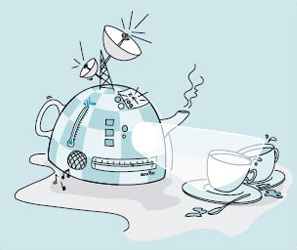1 Problems and innovation
1.1 Solving problems
It could be said that our species is defined by its irresistible urge to solve problems – it's what makes us human. Strange, then, that the word 'problem' has such negative overtones. I think that the root of this paradox is that the word is used both when we identify a need – the first link in the problem-solving chain – and when we undertake the process of meeting that need. It is the identification of the need and the realisation that it is real and must be met that creates the anxiety and the negative feelings ('Houston, we have a problem …'). The process of finding a solution is the exhilarating part that makes us thirst for more.
I think of my love of skiing. Sometimes I get to the top of a mountain and look down at the precipitous slope I must now descend to get back to safety and a good hot meal, and I am gripped by fear, perhaps even to the extent of wondering whether I'll survive this time. What provides the pleasure, apart from the thrill of speed, is using my skill (such as it is) to meet my need to be safe again.
'The Engineer: Skier on the Technological Piste' is perhaps too bizarre a title for a course, so welcome instead to T207_1 The engineer as a problem-solver: the nature of problems.
T207_1 is taken from an Open University course entitled 'The Engineer as Problem Solver'. The fact that we have prepared a course with this title shows that we think there is something useful to say about the process of solving engineering problems. It seems to imply that there is a technique to be learned – a preferred method. To a degree, this is true; experience has taught us that there are certain ways of proceeding which tend to lead to better solutions than others. This course is designed to give you a flovour of the skills and knowledge that will help you to make active and informed decisions when tackling your own engineering problems.
In engineering, solutions to problems come in three categories:
innovation by context;
innovation by development;
routine.
This is going to need some explanation, so here goes.
The categories differ from one another in the extent to which the solution is a step into the unknown, and this is why it may be chosen before the solution itself is known.
| Old technology | New technology | |
|---|---|---|
| New context | innovation | invention |
| Old context | routine solution | innovation |
As you can see, there are four sectors in the table, defined by the technological newness of the solution, and the newness of the context in which it is to be applied.
The 'customer' for the solution will often have a very definite idea of the sector in which they wish the engineer to operate. For example, a new heart pacemaker will be heavily constrained in many respects: only certain materials will have been approved for the casing, as they have to be biocompatible; certain safety features must be included, such as methods of making sure the casing is hermetically sealed, making the device immune to electromagnetic interference, limiting the power and frequency of the heart stimulation; as well as other limits such as on the minimum lifetime of the battery and the need to provide sufficient warning of its decline to allow it to be replaced in time. The list is much longer than this. The effect is to discourage excessive innovation (by which I mean a significant change to the way something is made or the way it works – or a new type of thing entirely) and the chances are that an innovation by development will be the order of the day.
We define innovation by development as changing the bit that doesn't work, or that could work better, to improve the function of the whole product or design for reasons of cost, performance, ease of manufacture or gaining competitive edge.
This tight constraining of innovation does not preclude entirely the invention of a new type of pacemaker, but it is unlikely that a manufacturer will be asking its engineers to throw away the rule book and dream up something new. If an innovative pacemaker is to appear, it will be because someone has had a sudden inspiration, and the idea is so very good and the potential benefits so great that a manufacturer is prepared to take a large risk and go through years of testing to gain safety approval.
It is usually where safety is a critical factor that we find a tendency to reduce the amount of innovation, so it would be equally easy to find an example from the oil industry, or from the aerospace or military fields. Very conservative purchasers are the other main reason for holding back on innovation. Perhaps surprisingly, the industrial process control market is one such area. Engineers responsible for the design and installation of processing plant usually take a lot of persuading that a new type of flowmeter, say, will be better than the one they know and have been using for many years.
At the other extreme, there are just as many examples where innovation is essential to the success of a project. There's even a well-known mail-order catalogue whose very name includes the word. The market for gadgets and gizmos is huge, and rather prone to the vagaries of fashion. These two characteristics make it a powerful driver for innovation. Last year's temperature-indicating tea cosy with built-in radio, flashlight and satellite navigation system may have sold a million, but it's a little passé now (Figure 1).

Another important instance where we know in advance that an innovation is required is where the existing technology is very mature, and has been incrementally developed as far as it is possible to take it, yet we have identified a need to improve the performance of the product still further. In this case, we can clearly see that innovation will be the only way to get there. An example of this is the bubble-jet printer. In the late 1970s and early 1980s, the vast consumer and small-business market for printers could not stand the cost of laser printers, yet was demanding better quality, less noise and higher speed from the alternative, which was the dot-matrix printer. This works by transferring ink from a typewriter ribbon onto the paper, using an array of electromagnetically actuated pins. These had been improved over many years, and were about as good as they could get. They had reached the limits of how fine a pitch they could be arranged on at a reasonable price but, even so, they were still rather slow and noisy.
What was required was an innovation, and this came in the form of the bubble-jet, which was an entirely new technology based on the ability to etch arrays of very fine holes in a polymer substrate using photolithography. The ink is transferred to the paper by creating pressure pulses behind the appropriate hole, using electrical heating. A single drop of ink is then ejected at high speed and strikes the paper. At a stroke, the new technology provided marked improvements on speed, pitch and noise level, and all without increasing the cost of the product.
